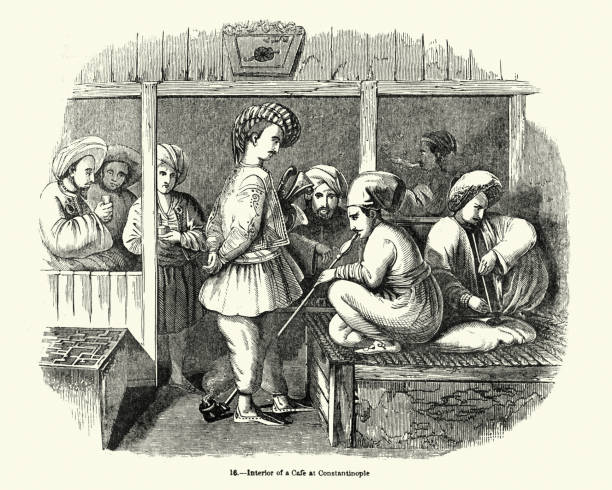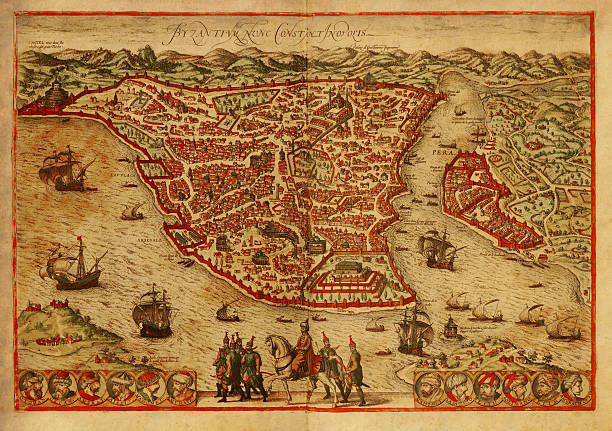Hey there, coffee aficionados and history buffs! Let’s journey back in time to the bustling streets of the Ottoman Empire, where the aroma of freshly brewed coffee wafted through the air.
Today, we’re exploring the fascinating role of coffeehouses in the Ottoman Empire—a tale steeped in culture, intellect, and camaraderie.

So, grab your favorite cup of java and let’s get started!
The Birth of a Coffee Culture
It all began in the 16th century when coffee made its grand entrance into the Ottoman Empire. As the imperial capital, Istanbul took center stage in this coffee revolution, giving rise to the first “kahvehane” (coffeehouses).
These lively establishments quickly became social and intellectual hubs, welcoming people from all walks of life. But coffeehouses were more than just places to savor a hot brew—they were catalysts for community engagement and cultural exchange.

The Intellectual Brewing Grounds
Ottoman coffeehouses were dynamic spaces where creative minds and curious souls converged. Here are some of the activities that made coffeehouses so vibrant:
- Poetry in Motion: Poets recited their latest verses, captivating audiences with the beauty of their words.
- Debates and Discourse: Scholars and thinkers engaged in thought-provoking discussions on everything from philosophy to theology.
- Telling Tales: Storytellers spun captivating yarns of adventure, romance, and intrigue.
- Music to the Ears: Musicians serenaded patrons with traditional Ottoman tunes. These cultural activities, alongside lively political debates and the spread of news, made coffeehouses the beating heart of Ottoman society.
Tradition in Every Cup

The Ottomans took their coffee seriously, and the brewing process was an art form in itself. From roasting and grinding the beans to serving the coffee in delicate cups, each step was steeped in tradition. With meticulous attention to detail, coffee was prepared with a reverence that elevated it from a mere beverage to a symbol of hospitality and connection.
A Force for Change
While coffeehouses were cherished for their cultural contributions, they weren’t without controversy. At times, political discussions grew fervent, leading to government scrutiny and even temporary closures. Yet, despite challenges, coffeehouses persisted as platforms for change, sparking dialogues that shaped the empire’s social and political landscape.
From Ottoman Empire to Modern Day
Centuries later, the legacy of Ottoman coffeehouses endures in modern-day Turkey and beyond. Though today’s coffee shops may differ in style, the essence of community and conversation remains. So, whether you’re savoring an artisanal latte or a traditional Turkish coffee, remember that you’re part of a rich historical tapestry.
Coffeehouses Then and Now: A Comparison

While the tradition of coffeehouses has a rich history in the Ottoman Empire, coffee culture has also evolved over time. To get a sense of how things have changed (and what’s stayed the same), let’s take a look at a side-by-side comparison of Ottoman coffeehouses and modern coffee shops:
| Ottoman Coffeehouse | Modern Coffee Shop |
|---|---|
| Social and intellectual hub | Mostly a place for leisure |
| Hosted poetry recitals | Hosts open mic nights and events |
| Venue for scholarly debates | Venue for casual chats |
| Storytelling and live music | Background music |
| Cultural and political hub | Business and study spot |
As we can see, Ottoman coffeehouses were dynamic centers of cultural and intellectual exchange, hosting everything from poetry recitals to scholarly debates. Today’s coffee shops often serve as cozy spots for relaxation, studying, or catching up with friends.
While some modern coffee shops host events like open mic nights, the atmosphere is often more casual than the spirited debates of Ottoman coffeehouses. Yet, despite the differences, the core values of community and connection remain central to coffee culture, both then and now.
A Toast to Timeless Tradition
So, whether you find yourself in a historic kahvehane or a trendy coffee shop, take a moment to appreciate the centuries-old tradition of coming together over a warm cup of coffee—a tradition that transcends time and place, bringing people together in the spirit of camaraderie and conversation.
And with that, we raise our coffee cups in a toast to the enduring legacy of coffeehouses, from the Ottoman Empire to the present day. Cheers!
Thanks for joining me on this journey through the annals of coffeehouse history! As you take your next coffee break, I hope you’ll remember the timeless allure of these remarkable establishments. Until next time, keep brewing, keep exploring, and stay curious!
For a deeper dive into the history of coffeehouses in the Ottoman Empire, be sure to check out scholarly sources like “Early Modern Ottoman Coffeehouse Culture“
Disclaimer: This post contains affiliate links, which means I may receive a small commission, at no extra cost to you, if you make a purchase using these links. Remember to support us by purchasing through the Amazon/Walmart/Impact Radius links provided. Last update on 2024-04-17 / Affiliate links / Images from Amazon Product Advertising API
Disclosure: No compensation or free products were received in exchange for writing this review.

Editorial Staff
The editorial staff at Crazy Coffee Crave is a team of coffee enthusiasts & Baristas who enjoy the one thing we all think about as soon as we get up in the morning. Trusted by thousands of readers worldwide.





